
Oncoplastic Breast Surgery
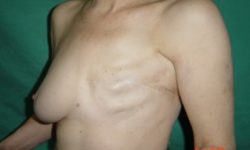
MASTECTOMY
Mastectomy is a surgery in which the entire breast is removed, including nipple, areola, total skin and the total breast tissue and sometimes other nearby tissues. It is the most effective treatment as a choice and it is also the most fearful choice for all women. It used to be the only choice before, but today there are many alternatives. You should keep in mind that there is always a possibility of reconstruction after mastectomy.
Now there are new techniques of mastectomy; nipple sparing mastectomy or skin sparing mastectomy. We will discuss these techniques in the following sections.
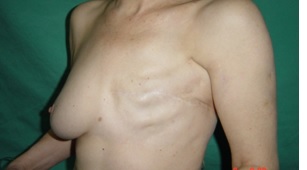
MASTECTOMY
Mastectomy is a surgery in which the entire breast is removed, including nipple, areola, total skin and the total breast tissue and sometimes other nearby tissues. It is the most effective treatment as a choice and it is also the most fearful choice for all women. It used to be the only choice before, but today there are many alternatives. You should keep in mind that there is always a possibility of reconstruction after mastectomy.
Now there are new techniques of mastectomy; nipple sparing mastectomy or skin sparing mastectomy. We will discuss these techniques in the following sections.

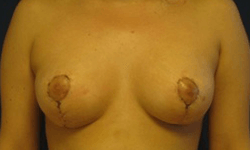
BREAST CONSERVING SURGERY (LUMPECTOMY):
A 48 years old patient with breast cancer at the right breast. Cancerous tissue is removed (lumpectomy) and immediate breast reduction and lifting is performed in both breasts .
Breast conserving surgery is a surgery in which some part of the breast containing cancer is removed. The main aim with this surgery is to remove cancer tissue as much as possible with surrounding normal tissue and still keep the cosmetic appearance of the breast. It has been widely used during the last decades but has some drawbacks.
There are some drawbacks with breast conserving surgery:
-You need a radiation therapy after this operation which may have serious side effects lasting for years
-There is a recurrence risk up to % 15 of the cases (Breast-cancer subtype, age, and lymph node status as predictors of local recurrence following breast-conserving therapy .Braunstein LZ, Taghian AG,et al. Breast Cancer Res Treat. 2017 Jan;161(1):173-179).


BREAST CONSERVING SURGERY (LUMPECTOMY)
A 48 years old patient with breast cancer at the right breast. Cancerous tissue is removed (lumpectomy) and immediate breast reduction and lifting is performed in both breasts .
Breast conserving surgery is a surgery in which some part of the breast containing cancer is removed. The main aim with this surgery is to remove cancer tissue as much as possible with surrounding normal tissue and still keep the cosmetic appearance of the breast. It has been widely used during the last decades but has some drawbacks.
There are some drawbacks with breast conserving surgery:
-You need a radiation therapy after this operation which may have serious side effects lasting for years
-There is a recurrence risk up to % 15 of the cases (Breast-cancer subtype, age, and lymph node status as predictors of local recurrence following breast-conserving therapy .Braunstein LZ, Taghian AG,et al. Breast Cancer Res Treat. 2017 Jan;161(1):173-179).
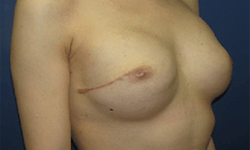
NIPPLE SPARING MASTECOMY
A 42 years old patient with breast cancer in both breasts. Nipple sparing mastectomy and immediate reconstruction is performed for both breasts
Nipple-sparing mastectomy is a variation mastectomy, sparing nipple areola complex and the skin of the breast with radical surgical removal of breast tissue. This is followed by immediate breast reconstruction with an implant or tissue taken from another area of the body.
In this surgical procedure, the surgical resection is performed by a multidisciplinary team comprising, a breast surgeon and a reconstructive plastic surgeon.

There are two beneficial affects with this surgery:
-with the right candidate oncologic safety withot leaving any cancerous or not breast tissue behind, and the cosmetic outcome.
-Radiation therapy is not necessary in most of the cases which may have very serious side effects.
This operation is much more technically challenging than other forms of breast cancer surgery operations and is especially important therefore that you ensure your surgeon has considerable expertise in this technique.


NIPPLE SPARING MASTECOMY
A 42 years old patient with breast cancer in both breasts. Nipple sparing mastectomy and immediate reconstruction is performed for both breasts
Nipple-sparing mastectomy is a variation mastectomy, sparing nipple areola complex and the skin of the breast with radical surgical removal of breast tissue. This is followed by immediate breast reconstruction with an implant or tissue taken from another area of the body.
In this surgical procedure, the surgical resection is performed by a multidisciplinary team comprising, a breast surgeon and a reconstructive plastic surgeon.
There are two beneficial affects with this surgery:
-with the right candidate oncologic safety withot leaving any cancerous or not breast tissue behind, and the cosmetic outcome.
-Radiation therapy is not necessary in most of the cases which may have very serious side effects.
This operation is much more technically challenging than other forms of breast cancer surgery operations and is especially important therefore that you ensure your surgeon has considerable expertise in this technique.


SKIN SPARING MASTECOMY
A 36 years old patient with breast cancer in right breast. Skin sparing mastectomy for the right and immediate reconstruction is performed for both breasts. Nipple is reconstructed after 6 months of the initial surgery
Skin-sparing mastectomy is a variation mastectomy, sparing the skin of the breast with radical surgical removal of breast tissue with nipple areolar complex. This is followed by immediate breast reconstruction with an implant or tissue taken from another area of the body.
If the cancerous tissue is too close to the nipple, there is a risk to leave residual cancel cells in the nipple. These patients are not goo candidates for nipple sparing mastectomy. Removal of the nipple but sparing of the skin is the choice of surgery with immediate reconstruction for these patients.
During the operation all patients must undergo intraoperative frozen section pathological analysis of the tissue samples behind the nipple at the time of pre-mastectomy. If cancer cells are detected during this produced nipple should be removed and skin sparing mastectomy and immediate reconstruction is performed. Nipple can be reconstructed in further surgery.
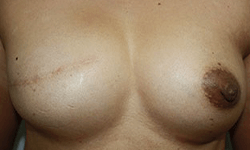
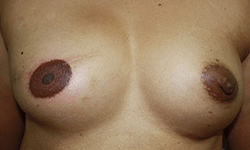
SKIN SPARING MASTECOMY
A 36 years old patient with breast cancer in right breast. Skin sparing mastectomy for the right and immediate reconstruction is performed for both breasts. Nipple is reconstructed after 6 months of the initial surgery
Skin-sparing mastectomy is a variation mastectomy, sparing the skin of the breast with radical surgical removal of breast tissue with nipple areolar complex. This is followed by immediate breast reconstruction with an implant or tissue taken from another area of the body.
If the cancerous tissue is too close to the nipple, there is a risk to leave residual cancel cells in the nipple. These patients are not goo candidates for nipple sparing mastectomy. Removal of the nipple but sparing of the skin is the choice of surgery with immediate reconstruction for these patients.
During the operation all patients must undergo intraoperative frozen section pathological analysis of the tissue samples behind the nipple at the time of pre-mastectomy. If cancer cells are detected during this produced nipple should be removed and skin sparing mastectomy and immediate reconstruction is performed. Nipple can be reconstructed in further surgery.


RECONSTUCTIVE BREAST SURGERY
The 44 years old patient had undergone a total mastectomy for cancer of the left breast 2 years previously. Multiple reconstruction techniques are performed with multiple operations for both breasts
You may have had a mastectomy previously and you have the option to rebuild your breast— a surgery called breast reconstruction. It can be done many months or even years after mastectomy. During reconstruction, breast shape is created using an implant or a flap tissue from another place of the body or both. In the hands of an experienced surgeon with the right technique, it is possible to achieve very satisfactory cosmetic results.


RECONSTUCTIVE BREAST SURGERY
The 44 years old patient had undergone a total mastectomy for cancer of the left breast 2 years previously. Multiple reconstruction techniques are performed with multiple operations for both breasts
You may have had a mastectomy previously and you have the option to rebuild your breast— a surgery called breast reconstruction. It can be done many months or even years after mastectomy. During reconstruction, breast shape is created using an implant or a flap tissue from another place of the body or both. In the hands of an experienced surgeon with the right technique, it is possible to achieve very satisfactory cosmetic results.
SENTINAL LYMPH NODE BIOPSY
If breast cancer spreads, it typically goes first to nearby lymph nodes under the arm pit. Even if lymph nodes are not enlarged or any cancer spread is not detected during the preoperative tests (MRI, PET) they still need to be tested during the breast cancer surgery. This procedure is called “sentinel lymph node biopsy”. This is done at the beginning of the any kind of breast cancer surgery to decide whether to remove the lymph nodes from the armpit ( axilla), or not. If cancer cells are detected at the armpit lymph nodes operation called “axillary lymph node dissection” should be carried out.


